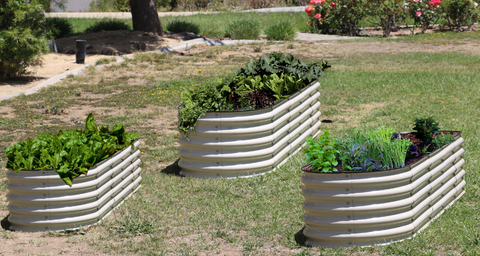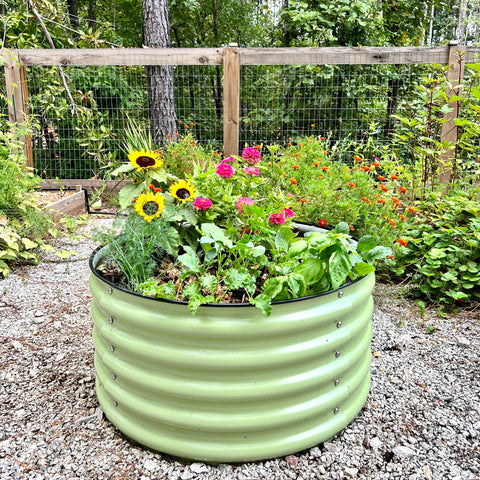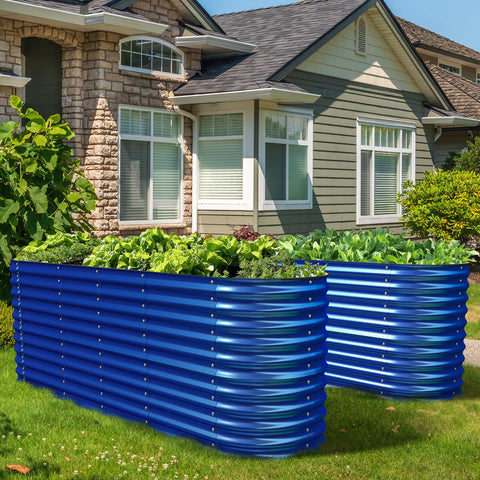9 Common Mistakes To Avoid When Using raised garden beds
Whether you are a novice growing your own vegetables in the raised garden beds or a general beginner in gardening, you will definitely make some mistakes here and there. In fact, everyone makes some mistakes at the beginning. You should learn from mistakes, so don't worry. In fact, before you start, we'll help you learn from some of the most common mistakes.

As you probably already know, a raised garden bed garden is ideal for providing a better harvest with less weeding work. In other words, some mistakes made at the beginning of the bed may lay the foundation for various problems of your crops. Here are the nine most common mistakes to avoid when using a raised garden bed garden, whether you are a beginner or an experienced professional.
- Positioning
Planting your garden in the wrong place is a huge mistake, and it is almost impossible to correct it with a garden bed. Once the soil, watering system and plants are in place, it is difficult to move or rearrange the garden beds.
First of all, consider the sun when setting up the garden bed. For example, if the bed is oriented east to west instead of north to south, the plants may not receive the right amount of sunlight. Vegetables need six hours or more of sunlight every day.
Putting plants that like sunlight in the shade - and vice versa - is another problem beginners may face. For example, tomatoes need at least six hours of direct sunlight every day. Eggplant, pepper and many herbs will perform well in the sunniest part of the garden bed, while lettuce or peas will perform better in the shade.
The plants on the south side will get the most sunlight, but they also need to grow lower to avoid blocking all sunlight from other crops.
- Materials
Unsafe materials, such as chemically treated wood or other pressure treated wood, should never be used to make elevated beds. Older materials may contain harmful creosote or chemicals harmful to your garden. However, in recent years, metal garden beds have become more and more popular among willing fans.
- Dimensions
Don't start too big. You want your garden bed to be the right size to make it easy to work indoors and around. The width of the garden bed should not exceed four feet, because you want to be able to reach the middle plants to work in your garden.
If your garden bed is near the fence, you may want to reduce the width to less than 30 inches. For best results, make sure there is enough space between multiple garden beds. You must be able to work comfortably between beds and across paths. Leave at least two or three feet between the beds.
- Watering
Overwatering is also a very common mistake that can cause your plants to drown and rot. On the other hand, underwater is also a big problem.
If you are not sure how much water the garden bed needs, please eliminate some guesses by investing in an irrigation system with an intelligent controller. Its humidity sensor will automatically adjust the water volume.
Your irrigation system does not need expensive or state-of-the-art technology to work properly and save you some time. That is, if a system is too expensive for you, just pay attention to the soil. When it looks hard, it's time to water it. If you can't tell from its appearance, take a handful and squeeze the soil into a loose ball.
If it stays together, the soil is just right. Indicating plants such as lettuce will quickly wither when dehydrated, and can also help you clearly determine whether your bed needs water.
If you do not plan to irrigate when building a garden bed, you need to use an old-fashioned watering can or a long hose for manual watering. If you are unable to establish an irrigation system, please put the rain bucket near the garden bed for convenience.
- Soil
Like organisms, soil will change and evolve over time. Its conditions will change with rainfall, runoff or drainage problems, and some plants will extract more nutrients from the soil than others. It is important to pay attention to the type of soil you use, its pH value and mineral level, and what organics may be needed to strengthen it.
The type of soil you fill your garden with is critical to your garden's future happiness. Never use regular potted soil on garden beds: it drains too quickly. You can find some better garden bed soil in the market.

- Herbicide
Using the wrong chemicals near the garden bed or directly can destroy your garden. Even if you use these chemicals elsewhere in the yard, the wind will bring toxins into your bed and kill your plants.
Chemicals containing herbicides will linger in the soil for many years and poison the soil. Of course, you will get rid of grass and weeds, but if you spray too close, you will lose your garden bed. When it rains, these toxins can also become dangerous because runoff can carry them to other parts of the garden.
Avoid the use of toxic herbicides. Select a mixture of equal amounts of hot water and vinegar to remove grass or weeds from the plant. Just pour the mixture on the problematic plant once a day until the leaves of the weeds turn brown, and then pull up the rest with your hands.
The path between garden beds may produce weeds and grass at some point, but rather than plan to trim and spray them, create a barrier. A small layer of organic covering on the top of the pressed cardboard box is an easy curing method, and the material has a longer service life than other options.
- Preparation
Preparing beds between seasons can bring health and happiness. If you neglect the soil preparation last year, the vegetables you planted may be stunted or ill if they grow.
Instead of planting the same vegetables year after year in the same place, it is better to plant healthier plants through rotation. Avoid putting plants of the same family close to each other or in the same place one by one. Common pests, fungal diseases and soil fertility are common problems faced by different types of plants.
- Selection of garden vegetables with raised garden beds
It is a mistake to choose the right vegetable in the right combination, and you can correct it later, but if you choose the wrong variety, your introduction to garden bed gardening may become more difficult.
Suppose you start with tougher vegetables, such as asparagus. Beginners may be discouraged and wait two or three years for the final harvest. Or, you may plant cool crops, such as lettuce, in the wrong season.
Start with some vegetables that are easier to grow, and learn about vegetables that work well on the garden bed, including:
Tomatoes
sweet basil
zucchini
Sweet pepper
Make sure that the options you choose are not only easy to grow, but your family will also like them. If your child is allergic, it is meaningless to grow tomatoes. Choose the vegetables you eat most, and you are unlikely to lose interest in the varieties in your garden.
It is also important that the options you choose work well in your yard. Some vegetables are more vulnerable to pests, and have poor effect in wet places, or cannot withstand the temperature fluctuations throughout the year. Consider the weather where you live.
Beginners may even want to plant an all herb garden from the first year, planting herbs that are easy to plant. You can plant them indoors and outdoors. The simplest herbs include:
sweet basil
thyme
Mint
parsley
Oregano
coriander
- Label
Mark the planting position or line of each new addition in the garden to avoid overcrowding. It's easy to forget to track where to plant what, but doing so can help you avoid replanting seeds because you mistake seedlings for weeds.

For best results, mark the location of each plant. Just put the small plastic labels in the store in the soil, or use the labels as you like.
Gardening is a process in which you make mistakes from time to time. Learning from these mistakes is the only way to progress. There is no harm in trying new things. Hopefully these tips will save you before you make the first mistake.
